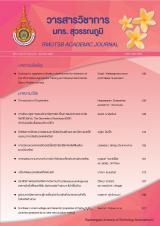การทดสอบความสามารถในการรับกำลังของบล็อกประสานประเทศไทย
Main Article Content
บทคัดย่อ
วัตถุประสงค์ของการดำเนินงานครั้งนี้ คือ ศึกษาเกี่ยวกับคุณสมบัติทางวิศวกรรมของบล็อกประสาน จากการเก็บก้อนตัวอย่าง 10 แหล่ง โดยการสุ่มจากโรงงานทั่วประเทศเพื่อตรวจสอบคุณภาพโดยเตรียมตัวอย่าง 2 แบบ แบบก้อนเดี่ยวและแบบแท่งปริซึม เพื่อหาค่ากำลังรับแรงอัด ค่าการดูดกลืนนํ้า และค่าความหนาแน่นแห้ง ใช้วัสดุเชื่อมประสานที่ใช้ปูนซีเมนต์ 2 ประเภทคือปูนปอร์ตแลนด์ และปูนซีเมนต์ผสม (ปูนก่อฉาบ) ในอัตราส่วน 1:2 ผสมนํ้าที่อัตราส่วนนํ้าต่อซีเมนต์ (w/c) เท่ากับ 0.75 พบว่ากำลังรับแรงอัดต่อก้อนของบล็อกประสาน จากทุกแหล่งผ่านมาตรฐานที่กำหนดไว้ที่ 70 กิโลกรัม/ตารางเซนติเมตร ได้ค่า fm’ อยู่ที่ 63-80 กิโลกรัม/ตารางเซนติเมตร ผลทดสอบการรับกำลังอัดแท่งปริซึม ได้ค่าอัตราส่วน h/t เท่ากับ 3.2 และค่าปรับแก้กำลังอัดเท่ากับ 1.12 ยังพบว่ารูปแบบของบล็อกประสานที่มีร่องเว้ามากและมีร่องแนวยาวเชื่อมถึงกัน และชนิดปูนปอร์ตแลนด์ การไหลที่ดีของวัสดุเชื่อมประสาน มีผลทำให้กำลังอัดของแท่งปริซึมมีกำลังอัดที่สูง รวมทั้งการทดสอบค่าการดูดกลืนนํ้ามีความสัมพันธ์กับค่าความหนาแน่นเป็นอย่างมาก จากการเขียนกราฟได้ความชันกราฟเท่ากับ -25 แสดงถึงว่ายิ่งมีความหนาแน่นมากเท่าไรค่าการดูดกลืนนํ้ายิ่งน้อยตามไปด้วย แสดงให้เห็นว่าตัวอย่างบล็อกประสานที่เลือกสุ่มมานั้น มีการควบคุมคุณภาพที่ดี ตั้งแต่การคัดเลือกวัสดุมวลรวมปริมาณส่วนผสมปูนซีเมนต์ ปริมาณนํ้าหนักต่อก้อน และการอัดขึ้นรูปด้วยเครื่องอัดที่มีกำลังสูง
The test of the compressive strength of an interlocking block of Thailand
The purpose of this research was to study on engineering property of interlocking blocks by selecting 10 random samples from factories around the country and check its quality. Two types of samples were prepared, including individual blocks and prism-shaped interlocking blocks aiming to find compressive strength, water absorption, and dry density. Binder materials were ordinary Portland cement and mixed cement in proportion of 1: 2 with water proportion of 0.75. It was found that the compressive strength of interlocking blocks from all sources passed the standard that was set at 70 kg/cm2 with fm’ at 63-80 kg/cm2. The test result on prism-shaped interlocking blocks was found h/t of 3.2 and compressive strength of 1.12. In addition, the shape of interlocking blocks, types of Portland cement and liquidity of the binder materials would cause the compressive strength of prism-shaped interlocking blocks to be higher. The water absorption was also related to the degree of density. The slope of the graph was equal to –25. This indicates that the higher the density, the less water absorption will be. This can explain the fact that the selected interlocking blocks had good quality control, ranging from the selection of materials, proportion of cement components, weight per blocks and high compressive strength.
Article Details
ต้นฉบับที่ได้รับการตีพิมพ์ถือเป็นสิทธิของเจ้าของต้นฉบับและของวารสารวิชาการ มทร.สุวรรณภูมิ เนื้อหาบทความในวารสารเป็นแนวคิดของผู้แต่ง มิใช่เป็นความคิดเห็นของคณะกรรมการการจัดทำวารสาร และมิใช่ความรับผิดชอบของมหาวิทยาลัยเทคโนโลยีราชมงคลสุวรรณภูมิ


